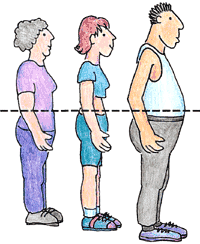One in Ten Canadian Adolescents is Abdominally Obese
Friday, October 29, 2010 Yesterday, at the 3rd Conference on Recent Advances in the Prevention and Treatment of Childhood & Adolescent Obesity, in Hamilton Ontario, I moderated a debate on whether or not advertising to kids should be regulated
Yesterday, at the 3rd Conference on Recent Advances in the Prevention and Treatment of Childhood & Adolescent Obesity, in Hamilton Ontario, I moderated a debate on whether or not advertising to kids should be regulated
The contestants were Dr. Yoni Freedhoff (of Weighty Matters fame), who eloquently supported the call for regulation, and Dr. Laurette Dube (Professor and James McGill Chair of consumer and lifestyle psychology and marketing, Desautels Faculty of Management, McGill University, Montreal), who, while not fully disagreeing with Freedhoff, made the point that regulating the food industry would be neither feasible nor enough.
Both debaters agreed that doing nothing was not an option, a view supported by the publication of the latest figures on adolescent and adult obesity in Canada.
Thus, in a paper just released online in Obesity Reviews, Ian Janssen and colleagues (Queens University, Kingston, Ontario and University of Ottawa, Ontario), describe the dramatic increased in the prevalence of abdominal obesity in Canadian adolescents and adults between 1981 and 2009.
Based on three national health surveys conducted in 1981, 1988 and 2007-2009, the prevalence of abdominal obesity in 12- to 19-year-old adolescents, measured as an increased waist circumference was 1.8% in 1981, 2.4% in 1988 and 12.8% in 2009, representing a 6-fold increase.
During the same time period, the corresponding rates for abdominal obesity in 20- to 69-year-old adults were 11.4%, 14.2% and 35.6%.
Between 1981 and 2009, the mean waist circumference increased more in women than in men both in adolescents (4.2 vs. 6.7 cm) and adults (6.7 vs. 10.6 cm).
While over 90% of adults with a BMI over 30 were also considered abdominally obese, it is important to note that abdominal obesity was also present in 35% of overweight adults (in the BMI range 25-30). This is an important finding, as it shows that simply being overweight can be associated with abdominal obesity, the main determinant of obesity related cardiometabolic risk.
Whether debating the pros and cons of regulating advertising to kids will effectively change this alarming situation in the foreseeable future certainly remains doubtful but I do agree that any kind of debate that draws attention to this issue is probably a good idea.
As Freedhoff pointed out (quoting Yale University’s David Katz), “When faced with a flood, stacking sand bags is a useful response – even if no single bag will stop the flood, each bag increases your chance of keeping the waters at bay”.
AMS
Edmonton, Alberta
Janssen I, Shields M, Craig CL, & Tremblay MS (2010). Prevalence and secular changes in abdominal obesity in Canadian adolescents and adults, 1981 to 2007-2009. Obesity reviews : an official journal of the International Association for the Study of Obesity PMID: 20977603


